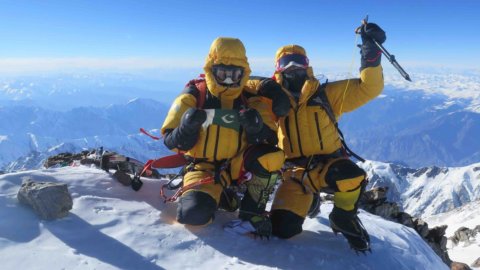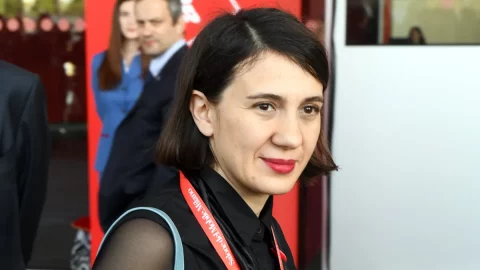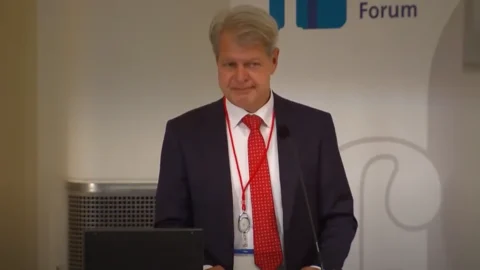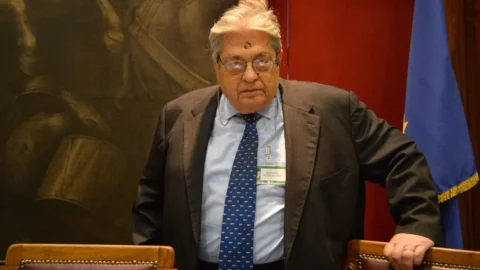Those who are passionate about mountaineering and helicopters know very well that Simone Moro, 48 years old from Bergamo open to the world, he is a special person. A month ago he entered the legend as the first and only mountaineer in the world to have climbed four 8000m peaks in the middle of winter (Shisha Pangma in 2005, Makalu in 2009, Gasherbrum 2 in 2011), and now Nanga Parbat, one of the highest of the Himalayan chains with its 8.125 meters.
Previously had climbed Everest four times and eight thousand meter peaks eight times. A pilot as well as a mountaineer, Moro also holds the world altitude record in a two-seater helicopter conquered by flying in 2015 at an altitude of 6.705 meters over the Dolomites. But Simone Moro is not special only for his records and his sporting exploits. It is so for his philosophy of life, for his human generosity and for his unshakable will to cultivate dreams bordering on the impossible, breaking his back with sacrifices but never losing humility. Even the way he looks at Italy today deserves to be taught in schools. “Reforming Italy is more difficult than climbing Everest but it's worth trying again”. Here is the interview that Simone Moro gave to FIRSTonline.
FIRSTonline – Mr. Moro, you were the first to climb the 8.125 meters of Nanga Parbat in winter and he is among the greatest in the history of mountaineering but he is also the world record holder for altitude in a helicopter: are the mountaineer and the aviator the two faces of the impossibility of a normal life?
SIMON MORO - Yes, they are two perfect metaphors of life or, at least, of my life. Being a mountaineer and being a pilot, the latter more frequently than the former, are two dreams that often appear and chase each other in life. In my case, being a mountaineer was the first and only answer I gave myself when as a boy I began to ask myself what I would have done when I grew up. Being a pilot is a dream that characterized the second part of my life but which, when I stop being a professional climber in 4 or 5 years, will become my main activity.
FIRSTonline – It's easy to say mountaineer or pilot, but how did your parents live your dreams?
SIMON MORO - My great fortune was to have a wonderful family. Of course, my parents were worried when I said as a child that I wanted to be a mountaineer, but they never killed my dreams and I can't thank them enough for that. They never dissuaded me, but only warned of the difficulties. They told me: if so far only one of the 5 billion inhabitants in the world like Messner has made it to being a professional and successful mountaineer, it means that it is not easy at all and therefore also be prepared to lose and prepare a plan B .
FIRSTonline – What was his plan B?
SIMON MORO - Studying, growing up, working, gaining emotional stability that I have found with my wife and my two children and looking for a normal life without giving up the dream and passion for the mountains. It was my strength.
FIRSTonline – When did he realize he had won his bet?
SIMON MORO - I understood it when I was 22-23, after university. Sporting successes and real sponsors arrived at the age of 26-27, but I understood earlier that I could do it, when I motor sciences graduate and when I realized that I was studying with immense passion a world that attracted me and that I could get to know better with appropriate studies. Bear in mind that I have always studied while working. When I was a boy, my day was divided into three parts: in the morning I worked in an automobile filing office, in the afternoon I worked out and in the evening I went to school. I never asked my family for a penny and it filled me with joy to cultivate my dreams by financing myself. It was hard, but when you have passion you don't feel the sacrifices.
FIRSTonline – Today, at the age of 48, who is Simone Moro in everyday life?
SIMON MORO - He is a professional mountaineer who finances his sporting ventures and collects enough to live in dignity with sponsorship contracts from Italian and foreign companies on which he pays taxes in Italy in the light of the sun. I am lucky to have found a wife, who climbs and competed in world ice climbing competitions up to two years ago, and to have two children (Martina and Jonas) who love sports and the mountains. Jonas and my wife live in Bolzano where I join them when I'm not in Bergamo, where I usually live. But, in addition to being a mountaineer, I am now an entrepreneur, I have written five books translated all over the world on my experiences in the mountains or in flight, I am often invited to hold motivational and incentive conferences for many companies and I have opened a climbing school with my brother. piloting, Altitude Helicopters in San Diego in the United States, where doing business is much easier than in Italy. It also helps that I speak five languages.
FIRSTonline – When you're not doing some sporting feat, is your everyday life more about climbing and flying or entrepreneurial activity?
SIMON MORO - 80% is made up of sporting activity. To accomplish the mountaineering feats I've done, you have to be an Olympic athlete and I run between 100km and 140km a week, lead a healthy life, climb mountains or in the gym and then fly with a helicopter. In the evening and often at night I spend hours writing, working on the computer and managing all my projects.
FIRSTonline – What drives you to seek out such crazy ventures? The passion for the mountains and for flying, the desire to amaze, the desire to make a dream come true, the pleasure of experiencing unique emotions or what else?
SIMON MORO - As children, reading "The Young Marmots" or Tarzan's books, we all dream of becoming explorers. I remained the little boy Pascoli spoke of and I transformed a dream into a permanent playful activity. Messner made me dream, as well as they made me dream of Robinson Crusoe but also Leonardo and Michelangelo. My life is testimony that there is still room for dreams and that you can live as a modern explorer. Mine is the best job I could do and it is no coincidence that many people call me to explain how one finds the strength to do, with so many sacrifices and with great humility, what I have done and am doing on the mountains and in the skies of all the world.
FIRSTonline – Mr. Moro, how do you see the world at an altitude of 8 meters and what life lessons leave businesses bordering on the impossible like yours?
SIMON MORO - There are mainly two sensations. The first is a feeling of smallness and humility: when you're up there you don't feel like Rambo and you understand that it doesn't take much to say goodbye to life. The second sensation is the pleasure of re-appropriating and rediscovering the simple things, which in everyday life we consider obvious but which aren't obvious, such as water, food, the warmth of a fire, the embrace of a Dear.
FIRSTonline – In a recent interview you said that in the mountains you must always keep your feet on the ground, you must climb slowly without looking for shortcuts, you must train your patience, you must learn to be afraid, you must do simple things and you must understand when it is time to stop: Are these tips that also apply in your everyday life?
SIMON MORO - When you've done certain feats and experienced extreme risk, those tips are worth even more in life. Today everyone wants everything and immediately, no one wants to break their backs from fatigue and, if something goes wrong, you always think it's the fault of others: the mountain teaches you that this is not how you should do it and also teaches you how to lose. Before conquering the summit of Nanga Parmat at 8.125 meters in winter or climbing Everest, do you know how many times I tried and failed? But woe to give up: to win you must know how to lose. Defeat is the premise or postponement of victory. It's a great life lesson that I learned climbing the highest peaks of the Himalayas.
FIRSTonline – Did you feel more joy when you reached the top of Nanga Parbat or when you made the altitude record in a helicopter reaching an altitude of 6.700 meters in the Dolomites?
SIMON MORO - Certainly when, for the first time in the history of mountaineering, I arrived with my companions Alex, Ali and Tamara, in winter at the top of Nanga Parbat, but the helicopter made me proud in another way and that is when I I bought one that cost a fortune and I'm still paying with bills, I disassembled it piece by piece to ship it to Nepal and after 70 days of activity it was already at break even. It was proof that another dream had come true despite no one helping me or wanting to at least today.
FIRSTonline – But how do you train yourself to face fear and extreme risk and how do you not panic when the Everest Sherpas threaten to kill you as happened to you?
SIMON MORO - Fear is human, biological, and should not be lived negatively: it is an odometer of the person's self-preservation. It is essential to experience fear and know how to listen to it, avoiding it from turning into panic: if you learn to do this, it means that you know how to manage emotions. The tensions with the Sherpas on Everest were obviously not the only time I felt fear, but they taught me to live with fear. If you master it, fear ultimately gives you more strength.
FIRSTonline – You have recounted your experiences in your books which have titles that speak for themselves ("8000 meters of life", "Everest, on the top of a dream", "The voice of the ice", "Kneel on the wings" or "Comet on Annapurna” ), but is there also a scientific and civil and humanitarian benefit from his exploits?
SIMON MORO - Sure. From my passion for helicopters, a helicopter rescue project was born in the Himalayas and the earthquake in Nepal confirmed how forward-looking the project was that I had the opportunity to implement. Furthermore, allow me to recall that, with the resources raised by the sponsorships of my mountaineering enterprises, it has been possible to create a school for 396 children in Nepal, a school for boys and girls in Pakistan, a small hospital under Naga Parbat.
FIRSTonline – What will he do after the Nanga Parbat record?
SIMON MORO - I will open up to different horizons. A little less 8000 meters and more unexplored and wild mountains, a more technical mountaineering even if I have in mind a winter climb….
FIRSTonline – You entered the mountaineering legend after Cassin, Compagnoni, Lacedelli, Bonatti, Messner: do these names mean that there is an Italian route to mountaineering that excels in the world?
SIMON MORO - The history of mountaineering has certainly been largely written by the Italians. From the Duke of Abruzzi in the early XNUMXth century to Riccardo Cassin in the XNUMXs, from Bonatti in the XNUMXs to Messner in the XNUMXs up to the present day, Italian mountaineering has excelled for over a century. However, the discourse must be broadened and must include the exploits of Christopher Columbus, Marco Polo or the scientific and artistic ones of Galileo Galilei, Leonardo da Vinci, Michelangelo. This is to say that mountaineering is a part of the Italian way to explore the world. We are a people not only brilliant but that applies its genius to the exploration of the world in every sense. The climbs are something more than a sporting feat but they are also the triumph of the intuition and strategic ability of the Italians.
FIRSTonline – Faced with a particular person like you, it is impossible to give up the metaphors between your exploits on top of the world and the tribulations of public life: today, according to you, Is it easier to climb Everest or to reform Italy?
SIMON MORO - It is certainly more difficult to reform Italy, because in our country there is no longer any room for dreams, there is too much and increasingly mismanagement and tax immorality. That's why I started a helicopter business in the United States. But I remain proud to be Italian, I live and pay (absurd) taxes in Italy and remain convinced that the crisis our country is experiencing can become an opportunity. I know it's hard but you can't give up and you have to try once again to change, rebuild our Italy like our old ones did. Just let them do it…





